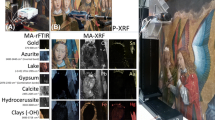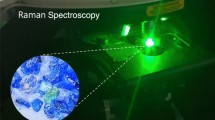Abstract
For the non-destructive identification of pigments and colorants in works of art, in archaeological and in forensic materials, a wide range of analytical techniques can be used. Bearing in mind that every method holds particular limitations, two complementary spectroscopic techniques, namely confocal μ-Raman spectroscopy (μ-RS) and μ-X-ray fluorescence spectroscopy (μ-XRF), were joined in one instrument. The combined μ-XRF and μ-RS device, called PRAXIS unites both complementary techniques in one mobile setup, which allows μ- and in situ analysis. μ-XRF allows one to collect elemental and spatially-resolved information in a non-destructive way on major and minor constituents of a variety of materials. However, the main disadvantages of μ-XRF are the penetration depth of the X-rays and the fact that only elements and not specific molecular combinations of elements can be detected. As a result μ-XRF is often not specific enough to identify the pigments within complex mixtures. Confocal Raman microscopy (μ-RS) can offer a surplus as molecular information can be obtained from single pigment grains. However, in some cases the presence of a strong fluorescence background limits the applicability. In this paper, the concrete analytical possibilities of the combined PRAXIS device are evaluated by comparing the results on an illuminated sheet of parchment with the analytical information supplied by synchrotron radiation μ-X-ray diffraction (SR μ-XRD), a highly specific technique.
Similar content being viewed by others
References
M. Mantler, M. Schreiner, X-ray Spectrom. 1, 3 (2000)
P. Vandenabeele, J. Raman Spectrosc. 8/9, 607 (2004)
G.D. Smith, R.J.H. Clark, Rev. Conserv. 2, 92 (2001)
C. Ricci, I. Borgia, B.G. Brunetti, C. Miliani, A. Sgamellotti, C. Seccaroni, P. Passalacqua, J. Raman Spectrosc. 35, 616 (2004)
K.S. Andrikopoulos, S.X. Daniilia, B. Roussel, K. Janssens, J. Raman Spectrosc. 37, 1026 (2006)
G. Falkenberg, K. Rickers, D.H. Bilderback, R. Huang, A Single-bounce Capillary for Focusing of Hard X-rays, HASYLAB Annual Report (2003)
K. Proost, K. Janssens, B. Wagner, E. Bulska, M. Schreiner, Nucl. Instrum. Methods Phys. Res. B 213, 723 (2004)
T.D. Chaplin, R.J.H. Clark, A. McKay, S. Pugh, J. Raman Spectrosc. 37, 865 (2006)
R.J. Gettens, E.W. Fitzhugh, Stud. Conserv. 2, 54 (1966)
H. Kühn, Stud. Conserv. 15, 12 (1970)
L. Burgio, D.A. Ciomartan, R.J.H. Clark, J. Raman Microsc. 28, 79 (1997)
L. Burgio, D.A. Ciomartan, R.J.H. Clark, J. Mol. Struct. 405, 1 (1997)
P. Vandenabeele, H.G.M. Edwards, L. Moens, Chem. Rev. 3, 676 (2007)
Author information
Authors and Affiliations
Corresponding author
Additional information
PACS
33.20.Fb; 61.05.cp; 33.20.Rm; 07.85.Qe; 91.65.An
Rights and permissions
About this article
Cite this article
Van der Snickt, G., De Nolf, W., Vekemans, B. et al. μ-XRF/μ-RS vs. SR μ-XRD for pigment identification in illuminated manuscripts. Appl. Phys. A 92, 59–68 (2008). https://doi.org/10.1007/s00339-008-4447-9
Received:
Accepted:
Published:
Issue Date:
DOI: https://doi.org/10.1007/s00339-008-4447-9




